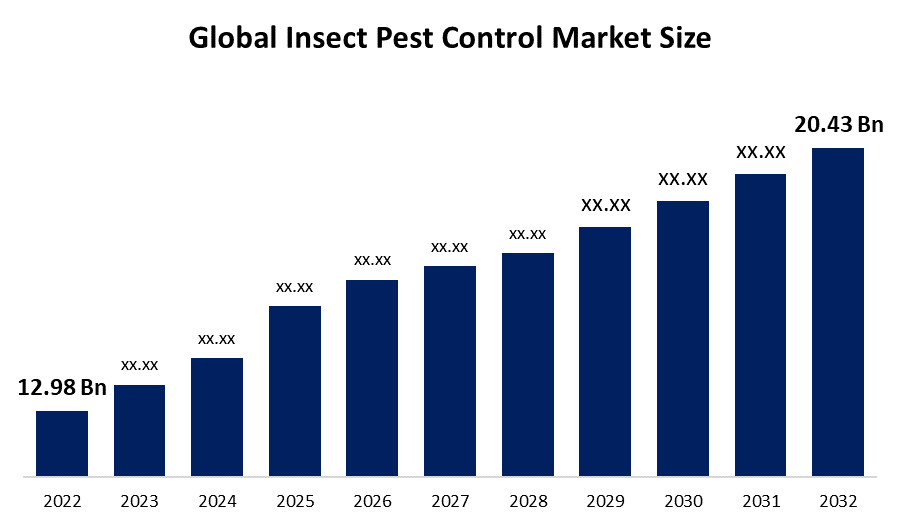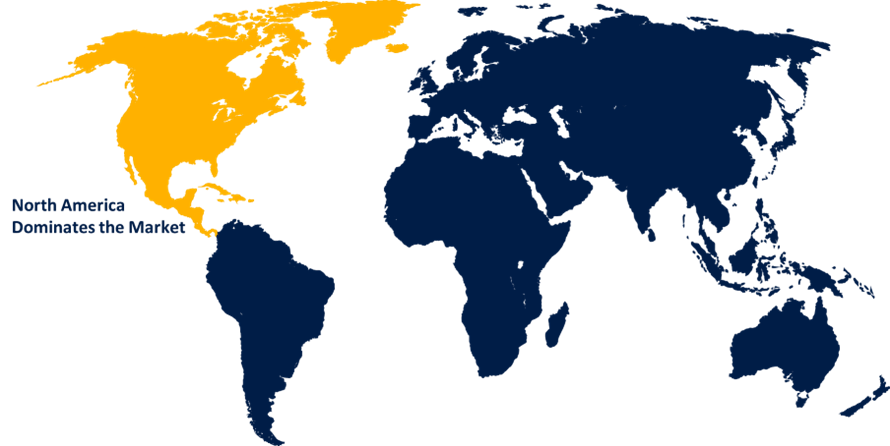Globaler Markt für Insektenbekämpfung - Größe, Anteil und COVID-19-Auswirkungsanalyse nach Insektenart (Mücken, Termiten, Kakerlaken, Bettwanzen, Fliegen, Ameisen und andere), nach Bekämpfungsmethode (biologisch, chemisch und physikalisch), nach Form (trocken und flüssig) und nach Region (Nordamerika, Europa, Asien-Pazifik, Lateinamerika, Naher Osten und Afrika), Analyse und Prognose 2022 - 2032
Industrie: Chemicals & MaterialsDer globale Markt für Insektenbekämpfung wird bis 2032 ein Volumen von 20,43 Milliarden US-Dollar erreichen
Laut einem von Spherical Insights & Consulting veröffentlichten Forschungsbericht soll der globale Markt für Insektenbekämpfung von 12,98 Milliarden USD im Jahr 2022 auf 20,43 Milliarden USD im Jahr 2032 wachsen, was einer durchschnittlichen jährlichen Wachstumsrate (CAGR) von 4,6 % während des Prognosezeitraums entspricht. Angesichts der steigenden Nachfrage nach Nahrungsmitteln und des gestiegenen Bewusstseins für durch Insekten übertragene Krankheiten scheint der globale Markt für Insektenbekämpfung Wachstumschancen zu haben. Es wird erwartet, dass der Markt in den kommenden Jahren stetig wachsen wird, angetrieben durch die Einführung innovativer Produkte und Dienstleistungen zur Schädlingsbekämpfung sowie einer zunehmenden Betonung umweltfreundlicher Schädlingsbekämpfungsmethoden.

Erfahren Sie mehr über diesen Bericht -
Durchsuchen Sie wichtige Brancheneinblicke auf 210 Seiten mit 151 Marktdatentabellen und Abbildungen und Diagrammen aus dem Bericht über „ Globale Marktgröße, Marktanteil und COVID-19-Auswirkungsanalyse für Insektenschädlingsbekämpfung nach Insektentyp (Mücken, Termiten, Kakerlaken, Bettwanzen, Fliegen, Ameisen und andere), nach Bekämpfungsmethode (biologisch, chemisch und physikalisch), nach Form (trocken und flüssig) und nach Region (Nordamerika, Europa, Asien-Pazifik, Lateinamerika, Naher Osten und Afrika), Analyse und Prognose 2022 – 2032“.
Insect pest control is the process of handling and regulating insect distribution through the use of various techniques. This technique can be used to protect trees, wood, crop production, and people from insect infestation. Pests are generally unwanted organisms that pose a threat to both property and human health. Among the numerous control procedures used are physical control methods, biological control methods, chemical control methods, and other control methods. Insect pest control products are used in a wide range of applications, including residential buildings, commercial and non-commercial institutions, livestock, and the industrial sector. The bulk end-users, which include hospitals, airports, hotels, commercial establishments, factories, and manufacturing plants, drive the demand for insect pest control. Non-commercial institutions, storage and transportation facilities, and public landscapes additionally contribute to the market. However, traditional insecticides can be harmful to both human health and the environment. These concerns have resulted in a shift towards more sustainable pest control methods, which may be less effective than traditional methods, limiting the market growth
Globaler Markt für Insektenschädlingsbekämpfung Berichterstattung melden
| Berichterstattung melden | Details |
|---|---|
| Basisjahr: | 2022 |
| Marktgröße in 2022: | 12,98 Milliarden USD |
| Prognosezeitraum: | 2022-2032 |
| Prognosezeitraum CAGR 2022-2032 : | 4.6% |
| 2032 Wertprojektion: | 20,43 Milliarden USD |
| Historische Daten für: | 2018-2021 |
| Anzahl der Seiten: | 268 |
| Tabellen, Diagramme und Abbildungen: | 110 |
| Abgedeckte Segmente: | Nach Insektenart, nach Bekämpfungsmethode, nach Form, nach Region |
| Abgedeckte Unternehmen:: | ADAMA, Rentokil Initial Group, Bayer, Ecolab, BASF, Arrow Exterminators, Inc., FMC Corporation, Sumitomo Chemical, Korea Henkel Home Care Co. Ltd., Bell Laboratories Inc., Syngenta, Ensystex, Terminix, Rollins, Inc. |
| Fallstricke und Herausforderungen: | COVID-19-Auswirkungen, Herausforderungen, Zukunft, Wachstum und Analyse |
Erfahren Sie mehr über diesen Bericht -
The mosquito control segment is expected to hold the largest market share during the prediction period.
The global insect pest control market is classified into mosquitoes, termites, cockroaches, bedbugs, flies, ants, and others. Because of the significant public health concerns associated with mosquito-borne diseases such as malaria, dengue fever, and Zika virus, the mosquito control segment is expected to hold the largest market share. The increasing awareness of these diseases, as well as the need for effective mosquito control measures, are driving the growth of this market segment.
The chemical segment is estimated to hold the largest share over the forecast period.
The global insect pest control market is divided into three segments based on control method: biological, chemical, and physical. The chemical segment is expected to have the largest share during the forecast period. The growth can be attributed to chemical control methods, which are highly effective in controlling insect pests and are widely used in a variety of applications, including agricultural pest control and others.
The liquid segment is anticipated to hold the largest market of insect pest control market over the forecast period.
The global insect pest control market is classified into two types: dry and liquid. Among these, the liquid segment is expected to have the largest market share of the insect pest control market over the forecast period. The growth can be accelerated as liquid products, such as sprays and insecticides, are more versatile and can be used to control a broader range of insects, including those commonly found outdoors, such as mosquitoes, flies, and ticks. In contrast, dry products such as baits and powders are typically used for indoor pest control and are effective against a narrower range of insects.
North America is expected to hold the largest share of the Global Insect Pest Control Market during the projected period.

Erfahren Sie mehr über diesen Bericht -
North America is expected to have the largest market share in the global insect pest control market during the study period. This is primarily due to factors such as increased public awareness of the health risks associated with insect-borne diseases, increased demand for environmentally friendly pest control solutions, and a greater emphasis on public health and sanitation. The United States is the largest market in North America for insect pest control products, owing to factors such as a high prevalence of insect-borne diseases like Lyme disease and West Nile virus, as well as a strong emphasis on pest control in residential and commercial settings. The Asia Pacific insect pest control market is expected to grow at the fastest rate during the forecast period. Rapid urbanization, a growing population, and rising demand for food safety and hygiene are driving the market for insect pest control products in the Asia Pacific region. Because of the rising demand for insect pest control products in countries such as China and India, this region's market is expected to grow at the fastest rate.
Major vendors in the Global Insect Pest Control Market include ADAMA, Rentokil Initial Group, Bayer, Ecolab, BASF, Arrow Exterminators, Inc., FMC Corporation, Sumitomo Chemical, Korea Henkel home care Co. Ltd, Bell Laboratories Inc., Syngenta, Ensystex, Terminix, Rollins, Inc., and Others.
Key Target Audience
- Market Players
- Investors
- End-users
- Government Authorities
- Consulting And Research Firm
- Venture capitalists
- Value-Added Resellers (VARs)
Recent Developments
- In March 2023, Zevo, America's fastest growing pest control brand1, has announced the launch of its new On-Body Mosquito + Tick Repellents, which offer odorless, non-sticky, and long-lasting protection against mosquitos and ticks.
Market Segment
This study forecasts revenue at global, regional, and country levels from 2020 to 2032. Spherical Insights has segmented the Global Insect Pest Control Market based on the below-mentioned segments:
Global Insect Pest Control Market, By Insect Type
- Mosquitoes
- Termites
- Cockroaches
- Bedbugs
- Flies
- Ants
Global Insect Pest Control Market, By Control Method
- Biological
- Chemical
- Physical
Global Insect Pest Control Market, By Form
- Trocken
- Flüssig
Globaler Markt für Insektenschädlingsbekämpfung, regionale Analyse
- Nordamerika
- UNS
- Kanada
- Mexiko
- Europa
- Deutschland
- Vereinigtes Königreich
- Frankreich
- Italien
- Spanien
- Russland
- Restliches Europa
- Asien-Pazifik
- China
- Japan
- Indien
- Südkorea
- Australien
- Restlicher Asien-Pazifik-Raum
- Südamerika
- Brasilien
- Argentinien
- Restliches Südamerika
- Naher Osten und Afrika
- Vereinigte Arabische Emirate
- Saudi-Arabien
- Katar
- Südafrika
- Restlicher Naher Osten und Afrika
Benötigen Sie Hilfe, um diesen Bericht zu kaufen?